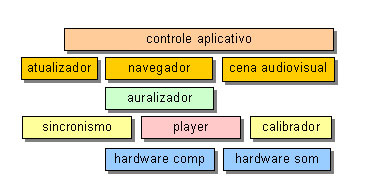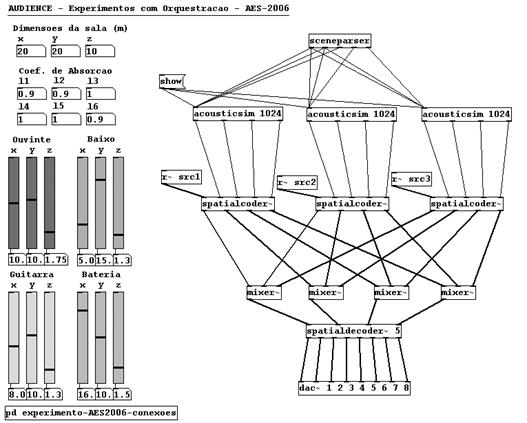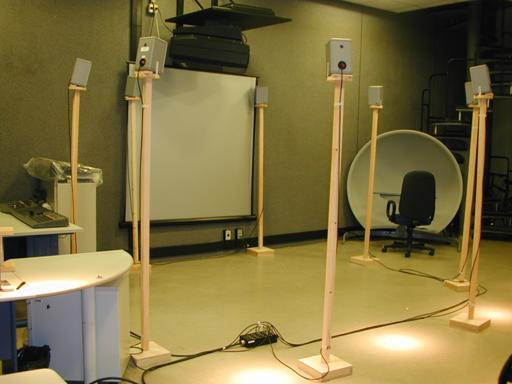|
The
AUDIENCE Auralization
System
The AUDIENCE for VR
is an integrated software
+ hardware system, composed
of a software auralization
machine and a hardware
multichannel distribution
and loudspeaker array.
The figure below shows
a functional block diagram,
expliciting the main
tasks and components
involved in a virtual
audiovisual scene auralization
process.

Task scenario and
main components of an
auralization system
In the highest level
of the hierarchy an
application (client)
withholds the control
of the auralization
system. In the level
immediately below we
have the navigation
function (which
controls the generation
of the audiovisual scene
for each position of
the user in the virtual
world), the descriptive
structure of data of
the audiovisual
scene, and a dynamic
data update module,
that makes the interface
with the user or with
another automatic module
updating the scene objects
dynamically.
The auralization
module is responsible
for the generation of
the audible part of
the audiovisual scene.
It is built with functional
components operating
in each functional layer
defined in the AUDIENCE
architecture.
A module is responsible
for the synchronism,
so that auralization
flows integrated to
the visual navigation.
A module allows to calibrate
the reference intensity
levels and "setup"
of the hardware and
software. Finally, the
reproduction layer will
play the final sounds,
using a player
available in the system.
In the lowest layer
we find the used computing
hardware and the
audio hardware
(the sound boards).
System General
Block Diagram
In order that the virtual
reality applications
can sound using some
auralization technique
we developed and investigated
some message passing
mechanisms through communication
protocols to allow the
control of the sound
synthesis from the virtual
reality application.
One proposal makes use
of asynchronous channels
for transmission of
commands and/or data
updates (physical parameters)
of all objects presently
in the acoustic scene,
serving the processes
that are controlling
the synthesis and the
acoustic scene auralization.
The usability and the
control of the integrated
audiovisual navigation
are basic questions
for complete immersive
virtual reality applications,
where itens as synchronization,
scene description resources
sharing, computational
load allocation, and
the interaction design
is vital and even critical
to get the desired final
effect. These requirements
of control and management
are necessary and are
foreseen in the conception
of advanced systems.
Below it is shown the
reference block diagram
for the implementation
of an Ambisonics auralization
machine, integrated
to a VR application.
An auralization engine
block diagram is shown,
integrated to a control
application (in the
case, a virtual reality
application, that can
be for example a game).

An auralization
machine block diagram
for VR
Blocks description
- VR Application:
The VR application
allows an user to
open a virtual audiovisual
scene in a given VR
platform and to navigate
and interact in this
environment. It is
a combination of softwares
having a 3D navigator
and a system of description
and setup of the audiovisual
scene (that is for
example described
using X3D), besides
the interface through
which the user will
interact. This data
delivery composing
the auditory scene
consists of functions
in the layer 1 (scene
description/composition).
- The application
commands a visualization
machine and an auralization
one. Inter-process
communication and
audiovisual synchronization
directives between
both must be guaranteed
by the global system
for the unicity of
the experience. A
parser block extracts
the scene data of
interest for the auralization
machine and sends
them (through data
passing mechanisms)
to the acoustic simulator,
responsible for the
functions in functional
layer 2.
- Sounds of the sound
sources and objects
in scene are recovered
from a data bank (e.g.
wavetables) or generated
by sound synthesis
(wavetable and/or
synth).
- The acoustic scene
modeling and rendering
takes place in the
auralization machine.
For this it is used
an acoustic environment
model, that is, one
technique to render
the sounds acoustic
propagation in the
environment. This
is a function in the
functional layer 2
for the generation
of sound fields in
the scene. Depending
on the size of the
scene or the strategy
of division of the
scene for distributed
auralization, some
auralization machine
instances are executed,
for example being
each one responsible
for the auralization
of an individual sound
source.
- The obtained sound
fields are encoded
into some adequate
spatial format, e.g.
the B-Format (1st.
order Ambisonics native
format) for its transmission
up to the reproduction
system or player.
- The spatialization
or auralization begins
with the 3D format
encoding and finishes
with the generation
of the signals for
each used loudspeaker.
- The decoding consists
on the calculation
of outpus for the
loudspeaker array.
A mixing stage to
combine soundfields
from each irradiating
sound source can be
necessary before decoding
(B-Format case) or
after.
- The reproduction
finally consists of
the amplification
and distribution of
the independent audio
channels to the output
transducers, the loudspeakers,
disposed in some output
mode (configuration)
which determines the
number of loudspeakers
and their positionings
around the listening
area. An auxiliary
system to calibrate
loudspeakers, intensities
and to equalize the
output channels is
desirable for high
levels of realism.
We use the PD (Pure
Date, from Miller Puckette)
as programming, synthesis
and sonification control
platform in the present
implementation (phase
III), and the X3D (from
the Web3D) as format
for scene description.
Another programming
and scene description
tools adequate to the
prototyping of setups
and patches in real
time would be the MAX/MSP
and the MPEG-4 Audio
BIFS format.
Software Description
An auralization machine
according to the AUDIENCE
architecture is a modular
software, having 4 layers
or main groupings of
ortogonal functionalities.
Each layer separately
executes distinct tasks
from the others, and
contains its proper
management structure.
The layers have a communication
interface that allows
that the outputs of
one be input to the
others. In this way,
the functioning of the
machine as a whole is
similar to one pipeline,
and its construction
can be oriented as software
plugins integration.
The current auralization
engines have been built
on the PD (visual programming
interface) in the form
of patches of functional
blocks. The PD offers
several advantages to
serve as basis in this
phase, due mainly to
its flexibility and
orientation to interconnectable
functional blocks (patches),
and due real time operation
facilities.
The figure below shows
the realization of an
auralization setup,
built with functional
blocks in the PD programming
plataform.

Functional blocks
of an auralization engine
built in PD
The figure shows the
blocks used to auralize
a scene with 3 musical
instruments employing
the software blocks
of the AUDIENCE system
in PD.
The room acoustic parameters
(e.g. walls absorption
coefficients, given
on the layer 1) are
informed in the input
blocks (above, to the
left). In this example,
sliders had been added
as user interface for
altering/updating the
position of the instruments
and the listener in
the scene (data from
layer 1). The "sceneparser"
block concatenates and
transmits relevant layer
1 data to the functional
blocks in layer 2, seen
below.
The layer 2 is represented
by block "acousticsim"
(acoustic simulator)
which calculates the
acoustic path from each
sound source (one for
each instrument). This
block output generates
impulsive responses
(IRs) valid for the
listener position.
The block "spatialcoder"
(right beneath, on layer
3) receives signals
(IRs) from layer 2 and
the anechoic sounds
(e.g. sound sources
wave files) to then
generate a spatial representation
of the sounds listened
in the scene (for instance,
in B-Format).
The blocks below the
"spatialcoder"
execute layer 4 functions
(mixing, decoding and
reproduction).
Besides the patches,
some special blocks
implementing specific
functions (such as ray-based
acoustic simulation
techniques) are developed
in C/C++ and then incorporated
to the AUDIENCE function
set in PD. This guarantees
freedom in the implementation
of specialized functions.
The AUDIENCE function
set and their inter-relationship
to model usage cases
is done employing UML.
Hardware Description
The AUDIENCE for Immersive
VR system hardware includes
basically:
(1) one or more processors
(e.g. PC nodes of a
cluster),
(2) one or more soundcards
or multichannel devices,
(3) one system for
audio channel distribution,
and
(4) an array of loudspeakers,
disposed in a given
geometry configuration.

Hardware for visualization
and auralization with
AUDIENCE at the Digital
Cave
Several modes or output
configurations are possible
with AUDIENCE. In our
research we have given
priority to multichannel
configurations where
loudspeakers are positioned
around the listening
area in a (regular)
specific geometry, such
as octagonal rings,
cubes (8 loudspeakers,
one per corner) and
even dodecaedrics. We
have also implemented
transcoders to (flat)
5.1 arrays, a format
much used in popular
home-theaters.
The picture below shows
a octagonal ring setup.
Regular configurations
present better acoustic
performance, uniformity
in sound field recreation
and less computational
cost to calculate outputs.

Octagonal setup
for loudspeakers
|









